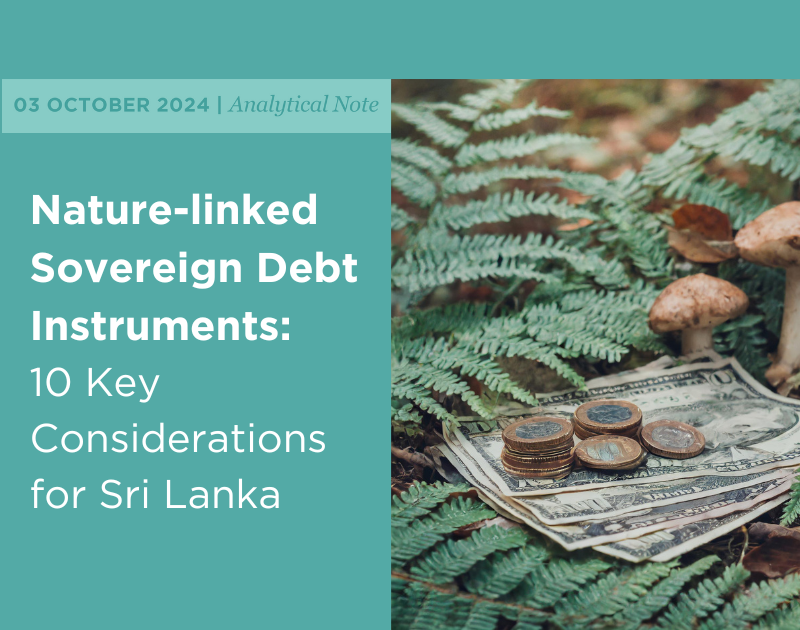
- Home
- Knowledge Insights
- Casting a Lifeline for Nature: Is a Debt-for-Nature Swap the Catalyst Sri Lanka Needs?
Debt-for-nature swaps (DFNS) are now emerging as a mainstream financial instrument, mobilising millions of dollars in conservation funding worldwide. Ecuador, El Salvador, Barbados, the Bahamas, Gabon, Belize and Seychelles have all successfully restructured debt while securing long-term environmental financing, with Ecuador and Barbados securing two large swaps within two years. The conservation funds generated from DFNS savings range from $4 million annually for 15 years in the case of the Belize Marine Protected Area (MPA) swap (a US$553 million DFNS) to US$23.5 million annually for 17 years in Ecuador’s most recent Amazon Bio-corridor swap (a US$1.53 billion DFNS).
Putting it in perspective
The 2025 national budget allocation for the Department of Forest Conservation, Department of Wildlife Conservation, and Department of Coast Conservation is LKR 10.3 billion (approximately US$35 million). Securing a swap yielding even $4 million annually for conservation is the equivalent of 10% of the annual budget for these three departments – arguably a significant amount in the Sri Lankan context. A swap in the range of Ecuador’s of US$ 23.5 million represented roughly 67% of their annual budget. For Sri Lanka, even a conservative post-debt restructuring DFNS could represent a substantial financial boost, especially given the low baseline for conservation funding.
Addressing the concerns: Sovereignty and feasibility
There are misconceptions that DFNS threatens national sovereignty. Some mistakenly believe it could result in Sri Lanka ceding control over sovereign land under the guise of conservation. Ecuador has not ceded control over the Galápagos MPA or its 6.4 million hectares of Amazonian territory—an area nearly the size of Sri Lanka. El Salvador has not ceded control over the Rio Lempa watershed. Neither has Barbados, the Bahamas, Gabon, Belize and Seychelles surrendered sovereignty over the 30% of their ocean territories as they expand their MPAs in line with the targets set out in the Kunming-Montreal Biodiversity Protocol target – which Sri Lanka is also a signatory to. Strict conservation agreements tied to DFNS can help strengthen, rather than weaken, domestic environmental governance.
Funding from DFNS is tied to conservation goals and implemented locally, engaging local organisations and government agencies—but with oversight from international conservation organisations and fund managers to ensure funds are transparently and appropriately disbursed. There is some concern expressed about the administrative fees, with critics arguing that they reduce the amount of conservation funding reaching local organisations. However, a well-managed fund that successfully meets its conservation targets can attract additional financing, ultimately leading to a greater net benefit. A high level of transparency and accountability should perhaps be welcomed, considering the chronic underfunding and weak implementation that has long plagued Sri Lanka’s conservation sector.
The other concern is whether Sri Lanka can manage to meet DFNS conservation commitments . Given past failures in public finance and conservation management, skepticism is valid. However, well-structured swaps include governance frameworks, international oversight, and expert technical assistance – all of which can ensure proper execution, long-term implementation, and meaningful impact.
Done correctly, a DFNS is an opportunity, not a liability.
Transparency and best practices matter
As investment banks and financial advisory firms approach Sri Lanka with DFNS proposals, transparency is critical. Best practices are evolving, with leading conservation organisations now working to standardise DFNS frameworks. The Nature Conservancy (TNC), which has facilitated five of the eight DFNS transactions to date, requires governments to conduct an open tender to select an investment bank as the arranger, ensuring the best financial and conservation outcomes. Given the various complex ways to structure a DFNS, competitive bidding is essential for securing the most favorable deal. However, certain aspects of the transaction are kept confidential to prevent influencing market prices—if the buyback cost rises during negotiations, it could undermine the feasibility of the swap, reducing potential savings and, consequently, funding for conservation.
Moreover, failure to execute a DFNS effectively or failure to meet conservation agreement obligations during the implementation phase could send negative signals to international investors, making Sri Lanka less attractive for future nature-based financing instruments and climate finance opportunities.
Post-restructuring: Is a DFNS still worth it?
Some argue that Sri Lanka’s post-restructuring status reduces the incentive for a DFNS, assuming such deals only benefit severely debt-distressed economies by securing large debt discounts. However, this overlooks the conservation imperative at the heart of these swaps. The primary argument for a DFNS is that it is not just for debt relief—it is about unlocking consistent, long-term conservation funding that Sri Lanka sorely lacks. Without a DFNS, Sri Lanka will continue relying on ad hoc, short-term grants and an underfunded budget, leaving its national parks, coastal ecosystems, and marine biodiversity critically under-protected. Moreover, a well-executed DFNS signals global commitment to conservation, attracting further climate and biodiversity finance.
From a debt management perspective, every rupee saved matters. Even a smaller swap—provided transaction costs are kept in check—may be better than no swap at all. This is especially crucial as fiscal pressure continue, and Sri Lanka is set to allocate 60% of its expected revenue to interest payments in the latest budget (2025). A well-structured DFNS remains both financially and ecologically valuable, offering an opportunity to secure long-term conservation funding, even in a post-restructuring scenario.
A lifeline for conservation in Sri Lanka
With chronic underfunding of conservation and climate resilience, Sri Lanka cannot afford to miss this opportunity. A well-executed DFNS would be one of the most consequential financial decisions for Sri Lanka’s environmental future, providing critical long-term financing. It would also introduce new mechanisms to attract and manage conservation finance, while embedding strong environmental governance practices. Ultimately, it could provide a critical financing lifeline for Sri Lanka’s ecosystems, biodiversity, and the livelihoods that depend on them.
This article is part of an ongoing series exploring climate finance, sovereign-debt, and financing of nature. A forthcoming CSF research paper (April 2025) goes into depth analysing several DFNS transactions and draws out critical success factors, vital takeaways, and key considerations for Sri Lanka. For previous work in this area, read our Blue Bonds Knowledge Primer, Conservation Trust Funds Knowledge Primer, and our Analytical Note on Sovereign Debt and Nature Finance.


